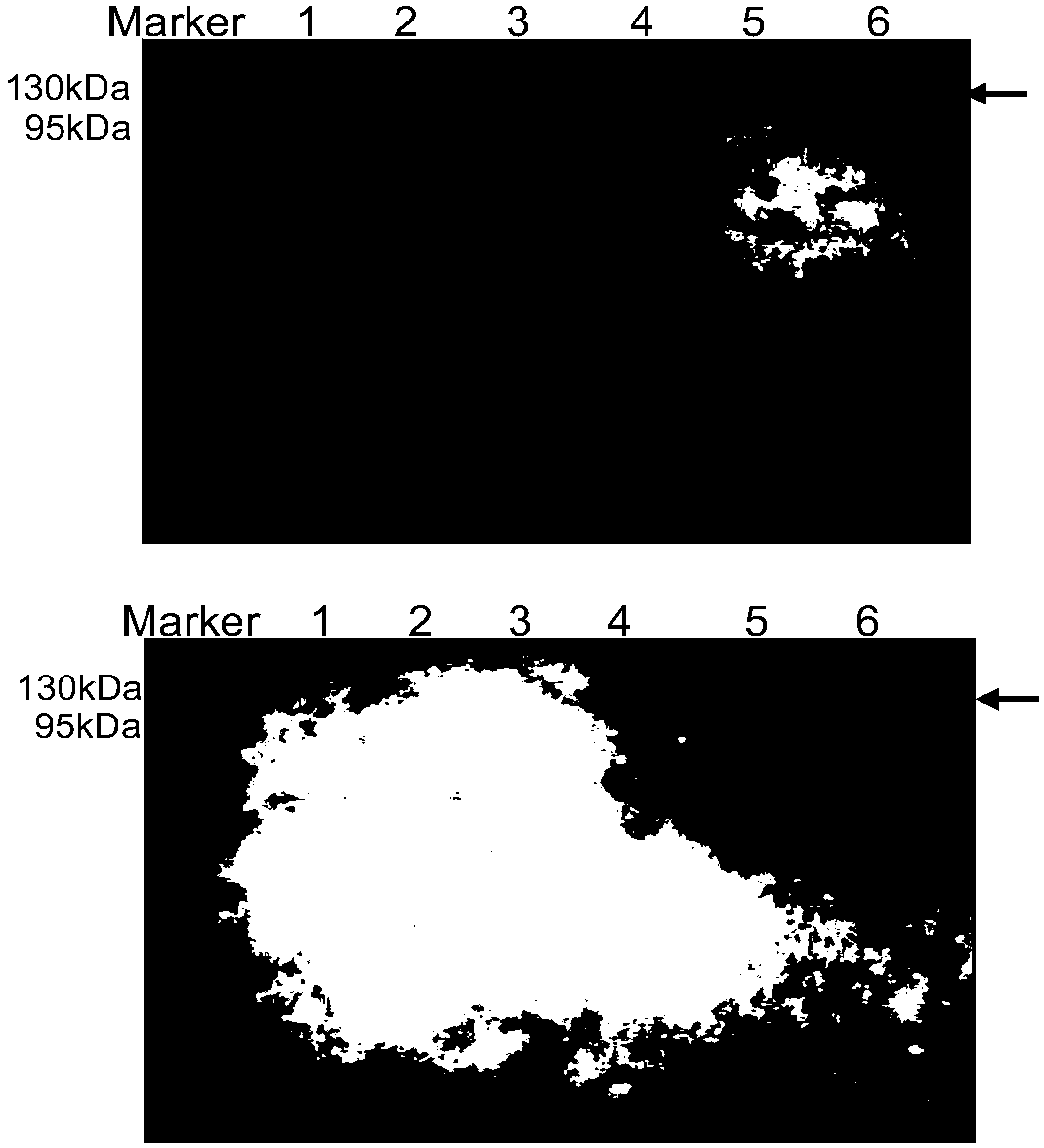Gene engineering bacterium for preparing Ebola virus nucleoprotein antigen and application
A technology of genetically engineered bacteria and Ebola virus, applied in the direction of viruses/bacteriophages, viruses, viral peptides, etc., can solve the problems of difficult large-scale preparation, low protein expression, low sensitivity, etc., and achieve simple, fast, and remarkable specificity in the preparation process Non-degradable, non-degradable effect
- Summary
- Abstract
- Description
- Claims
- Application Information
AI Technical Summary
Problems solved by technology
Method used
Image
Examples
Embodiment 1
[0039] A genetically engineered bacteria for preparing Ebola virus nucleoprotein antigen is obtained by the following steps:
[0040] A. PCR-amplified gene: the original gene template name pCRII-enp, provided by the research group of Wei Hongping, Wuhan Institute of Virology, Chinese Academy of Sciences (verified by sequencing). The forward primer is 5ˊ-GGATCCATGGATTCTCGTCCTCAGAAAAT-3ˊ(F), and the reverse primer is 5'-GTCGACTCACTGATGATGTTGCAGGATT-3'(R). The PCR reaction reagents are as follows: 5μL of 10×ExTaq polymerase buffer, 1μL of 2.5mM dNTP Mixture, 1 μL of primer F (10uM), 1 μL of primer R (10uM), 1 μL of amplification template, 1 μL of ExTaq HS DNA polymerase (5U / ul) and 40 μL of sterile water, PCR reaction conditions: 94°C Pre-denaturation for 300 seconds; denaturation at 94°C for 30 seconds, renaturation at 58°C for 45 seconds, extension at 72°C for 30 seconds, 35 cycles; final extension at 72°C for 600 seconds. The PCR amplification product was subjected to agarose...
Embodiment 2
[0044] The preparation method of Ebola virus nucleoprotein antigen comprises the following steps:
[0045] A. Inoculate the cloned strain pET-28a-ZEBOV-NP / BL21(DE3) into 5 mL of fresh LB medium (add 50 mg / ml kanamycin at 1:1000), and cultivate overnight.
[0046] B. Take an appropriate amount of culture and add it to fresh LB at 1:100 (at the same time, add 50mg / ml kanamycin at 1:1000 to inhibit the growth of miscellaneous bacteria), incubate at 37°C for 3 hours, and measure OD600=0.2-0.4.
[0047] C. Add the inducer IPTG to induce protein expression. The induction conditions are: IPTG concentration 0.4mM, induction temperature 37°C, induction time 3h. After induction, the cells were isolated by centrifugation at 8000 rpm for 10 min.
[0048]D. Pour out the medium residue, resuspend the cells with an appropriate amount of PBS (usually use 1 / 10 volume of the culture liquid), ultrasonically disrupt the cells to OD600<0.1, centrifuge at 12,000 rpm for 10 minutes, and separate th...
Embodiment 3
[0051] Western-blot detection of Ebola virus nucleoprotein, the steps are:
[0052] A. Ebola virus nucleoprotein prepared by the above method and corresponding negative control and positive control are subjected to SDS-PAGE electrophoresis ( image 3 );
[0053] B, 100mA, 1 hour, transfer the sample to PDVF membrane;
[0054] C. 5% (m / v) skimmed milk powder, blocked overnight at 4°C, and washed 3 times with TBST (containing 0.05% (v / v) Tween-20), with an interval of 10 minutes each;
[0055] D. Dilute the self-prepared specific polyclonal antibodies (Ebola virus nucleoprotein antibody ENP and Marburg virus nucleoprotein antibody MNP) to 1:2000 times as the primary antibody, and incubate at room temperature for 1.5 hours;
[0056] E. After washing 3 times with the same method, add 2000-fold diluted secondary antibody-AP-labeled goat anti-rabbit IgG (Beyotime, CAT NO: A0239), and incubate at room temperature for 1.5 hours;
[0057] F. After washing, the membrane was added to ...
PUM
 Login to View More
Login to View More Abstract
Description
Claims
Application Information
 Login to View More
Login to View More - R&D
- Intellectual Property
- Life Sciences
- Materials
- Tech Scout
- Unparalleled Data Quality
- Higher Quality Content
- 60% Fewer Hallucinations
Browse by: Latest US Patents, China's latest patents, Technical Efficacy Thesaurus, Application Domain, Technology Topic, Popular Technical Reports.
© 2025 PatSnap. All rights reserved.Legal|Privacy policy|Modern Slavery Act Transparency Statement|Sitemap|About US| Contact US: help@patsnap.com



